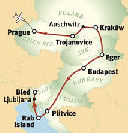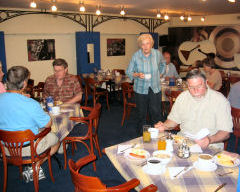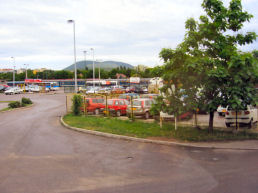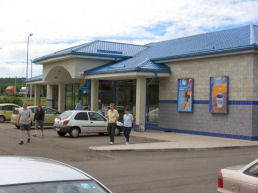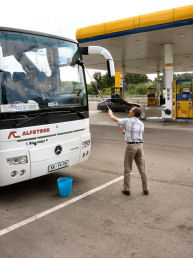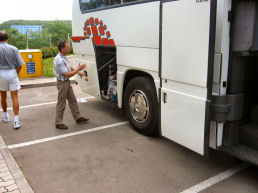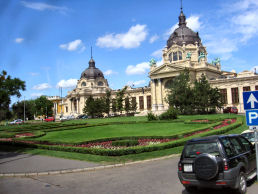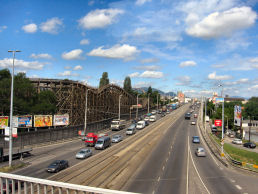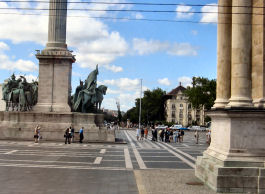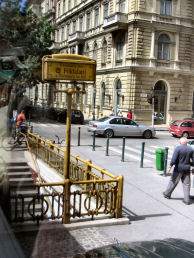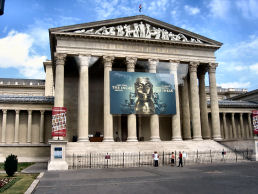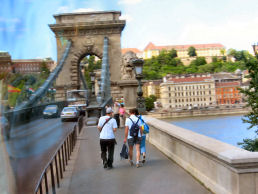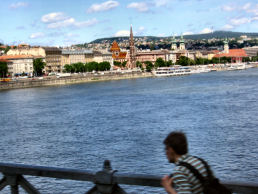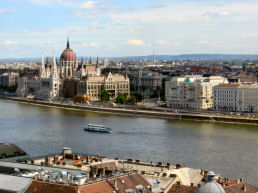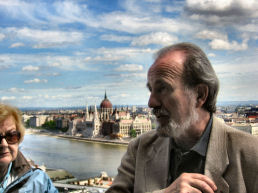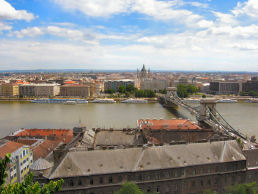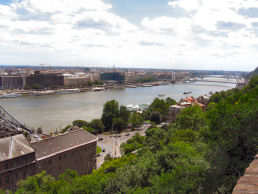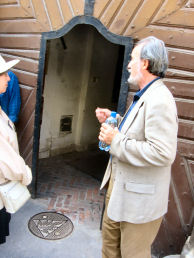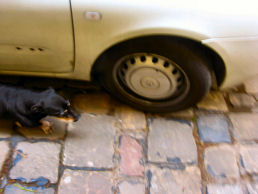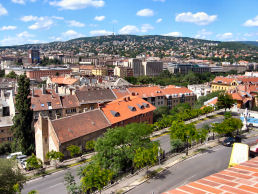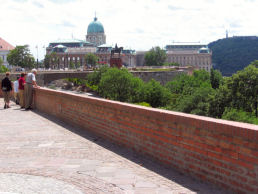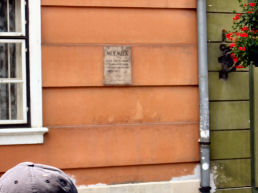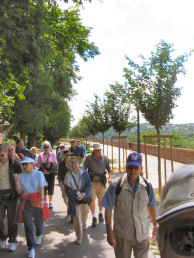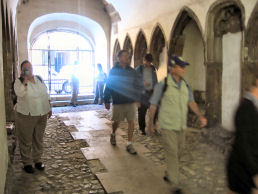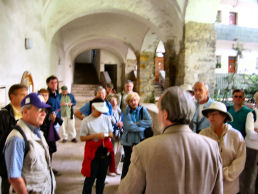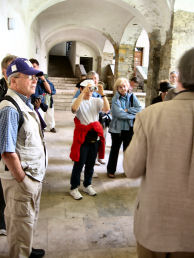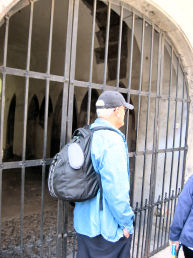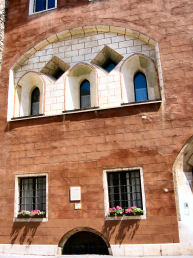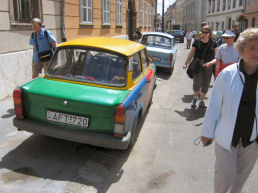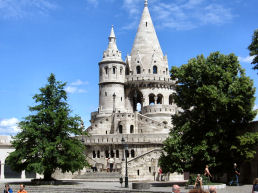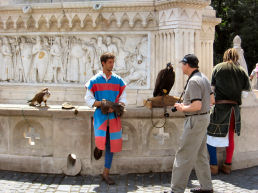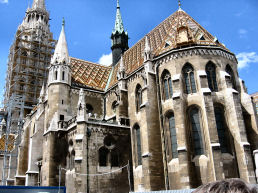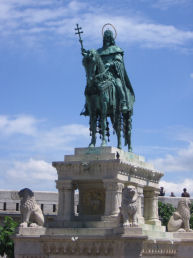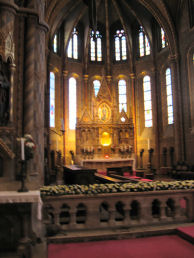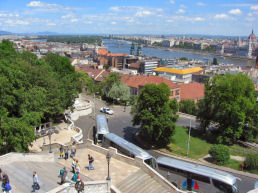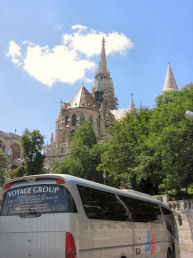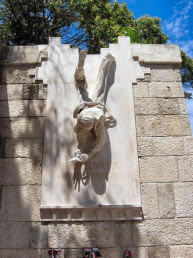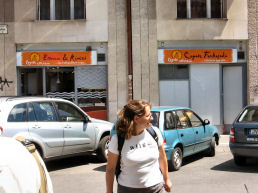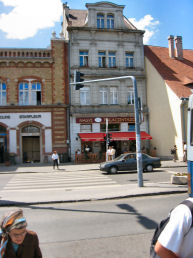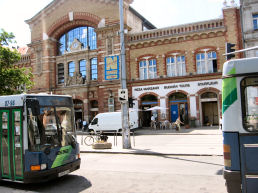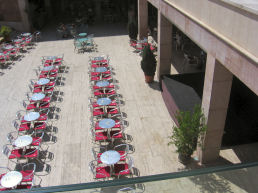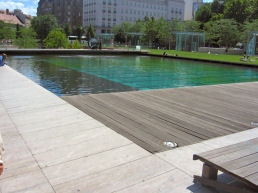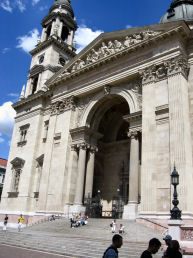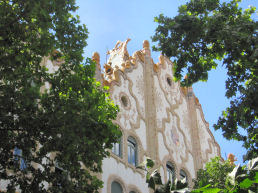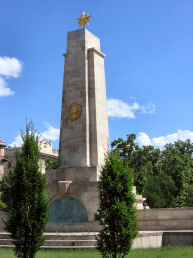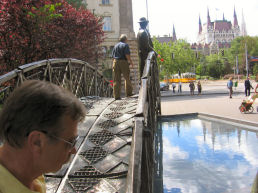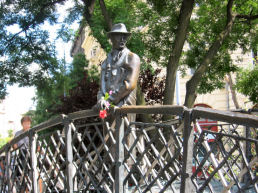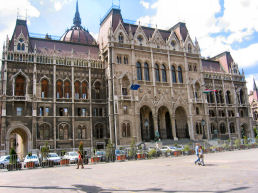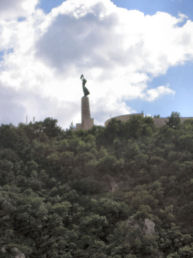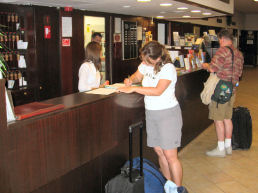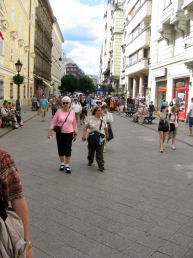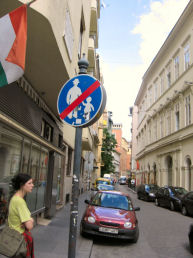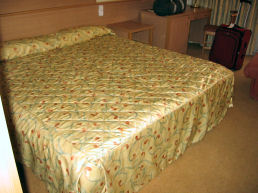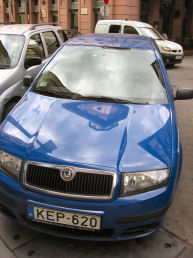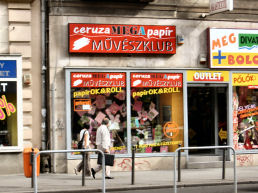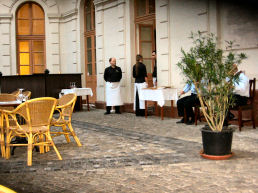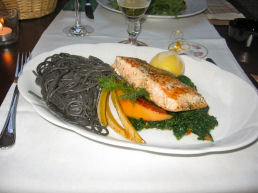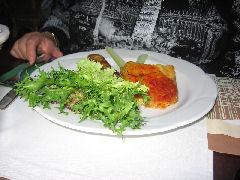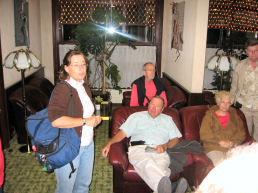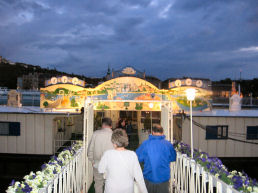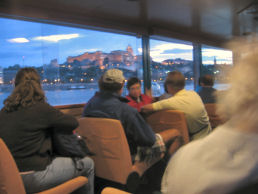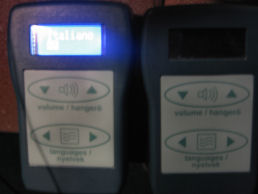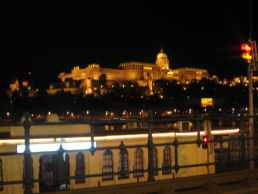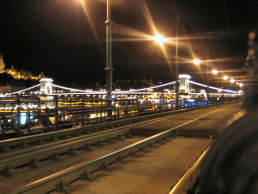The water in the Hotel Minaret was not very cold, it was full of particulates, and it tasted a little funny. However, it was great for shaving. What was not great was the sink. It did not have a stopper.
Some people complained that their rooms were quite small. Ours was pretty good-sized. We even had a desk, a table, and three chairs. Some people had poor lighting. We had bright overhead lights. I hope no one finds out that we got one of the good rooms.
I was pretty much caught up on my journal! This was unprecedented. On previous trips I was consistently a day or more behind. [Actually, Day 8 was left as fragmentary notes that I had to puzzle over more than a month later.]
I followed Patti and Tom down to breakfast. Some scrambled eggs and hot dogs were available this time. I also had a bowl of cereal, juice, and coffee. The hotel’s offerings were my least favorite of the breakfasts thus far. The ambience was nice, but they did not offer any fruit at all. Sue did not make it down to breakfast until almost 8 a.m. Evidently not much was left for her to eat. The early bird gets the hot dog. Shortly after the bus departed from the hotel we passed the train station at which Patti and Sue arrived from their adventure in Slanec. I tried to take a picture. Even though we were stopped, I could not get a very good angle. Trees were in the way.It was cloudy and cool as we departed the town. At some point on the highway to Budapest the sun came out as we drove through the flatlands of Hungary.
Susana gave a lecture on the nature of Hungarians. She said that they liked to party whether they were happy or sad. However, they were generally very formal. They loved classical music. They tended to dress up for concerts, get there early, and sit around drinking coffee and watching one another.
A favorite herb-flavored brandy in Hungary was Unicum. A toned-down version aimed at the tourist market was called Unicum Next. Hungarians never clinked glasses when they made a toast. When the Austrians shot down rebellious Hungarians, they were seen to clink their glasses in celebration. In 2007 the total population of Hungary was about ten million. Another two million ethnic Hungarians had migrated to other countries. Hungary lost approximately two-thirds of its territory – including its heart and soul, Transylvania – and half of its population after World War I. The population of the city of Budapest was about two million in 2007.Hungary east of the Danube was surprisingly flat. In fact, the Carpacian basin extends all the way into Asia. The Magyars migrated to this area from central Asia in 895 or 896. They attacked and conquered other areas as far west as the Pyrenees. Susana told us that the first Christian king, István, was crowned (by Pope Sylvester II?) on Christmas Day, 1000. Could this be right? I never read about István coming to Rome. I sincerely doubted that Sylvester journeyed to Hungary. [Pope Sylvester did not in fact crown István. A legend with little documentary basis claimed that the pope had sent him a crown.] István is now a saint.
Janoš Hunyady was the greatest Hungarian hero. He defeated the Ottoman Turks in the Battle of Belgrade in 1456. Pope Callixtus III called for all of the bells in the city of Rome to be rung. The son of Janoš Hunyady, Mátyás Corvinus, became King of Hungary. Hungarians have ever since said that justice died when King Mátyás died.
The Ottomans captured Budapest in 1536 and moved the capital to Bratislava. The Turks were responsible for instituting the hot springs baths in Budapest. After World War I Hungary was ruled by an admiral named Horty. The people referred to themselves as a kingdom without a king ruled by an admiral without a navy. Horty collaborated with the Nazis. That strategy seemed to work OK for a while, but eventually Hitler demanded that the Arrow and Cross party assume power in Hungary. The Hungarian Jews were spared for a while, but eventually 600,000 were deported in 1944. Budapest was destroyed in World War II. It was the site of a huge battle between the Nazis and the Russians. The Germans destroyed the bridges. American bombers destroyed almost everything else. So, we helped destroy the infrastructure of Budapest in order that the Russians could have whatever was left. The Hungarian form of Communism was not as harshly repressive as that practiced in neighboring countries. It was called “goulash Communism,” which meant that no one starved to death. In the 1970’s the World Bank even lent money to the Hungarian government. In 1989 Hungary opened its borders. This act allowed many East Germans to escape from behind the Iron Curtain. Bojan drove the bus right down Andrassy Ut, which meant that we got to preview many of Budapest’s best attractions. I had only been in town for about five minutes when it became evident that our two nights in Budapest would not be enough.Bojan then drove the bus across the Danube via the Chain Bridge.
We met our local guide, Elemer, at a point that was just about as high as one can go in Buda short of Gellert Hill. Susana had introduced him to us as a Professor of Sociology. I liked him almost immediately because of his strong sense of irony, a quality that I treasure more than almost anything. However, his insistence that Budapest, along with Florence and Venice, was one of the three wonders of the Renaissance, seemed more than a little far-fetched to me. I do not recall anyone in either Florence or Venice eagerly associating themselves or their artistic heritage with Budapest. It is easy to name great artists who flourished in the Italian cities, but I have never heard of these Hungarian Renaissance artists. How Rome, which funded most of the works of Michelangelo and Raphael, or Milan, in which Da Vinci toiled for many years, could be excluded from this analysis was equally puzzling. I remembered that Mona Winks had said that the Renaissance moved from Florence to Venice to Rome.The Chain Bridge and the tunnel to which it leads were designed to be exactly the same length. They were constructed by a Scotsman (Susana and the video on the Danube Cruise boat) or an Englishman (Elemer) named Adam Clark. The Ottomans ruled the city for 150 years. In 1686 the Austrian liberators destroyed everything. There is therefore little or no ancient architecture in the city.“Pest” means furnace. The name of the eastern part of the city refers to the hot spots beneath the city. Buda, of course, also has thermal springs, but its name is probably derived from Attila’s brother, who was the religious leader of the Huns. Elemer said that his name could conceivably be related to Buddha.
Genghis Kahn swept through this area in the fourteenth century. Eastern Hungary is like Kansas; there are no physical barriers to conquering armies at all. Since the Mongols' time, they have been liberated by the Turks, the Christian Hapsburgs, the Nazis, and the Russians. There may have been others. They have had a diet or parliament since 1214. This seemed strange to me, since during much of that time the Hungarians have been ruled by other nations. Parliament was revived in the nineteenth century when the “compromise” with the Hapsburgs was reached. The physical site of the parliament has moved around. It is now housed in a neo-Gothic structure on the Pest side. The Nazis used the building as a headquarters starting in 1944. Hungary’s greatest moment came in 1456 when Hunyady Janoš repelled the Turkish attack on his fort at Belgrade. Elemer called this a crusade, but I do not think that it technically qualified as a crusade. Pope Callixtus III certainly tried to launch a crusade during this period, but none of the western princes was interested. He build up a fleet, but it just rotted in the Tiber. Evidently he ordered all the church bells rung in celebration of the victory. For some reason the residents of Budapest seem to be proud of that. St. John da Capistrano was somehow involved in all of this. [I looked this up. John was a Franciscan. He preached in favor of a crusade against the Turks. A lot of peasants joined Hunyady’s small force of mercenaries and nobles with horses. This unruly bunch attacked the Turks against orders. Hunyady’s soldiers were forced into action and somehow succeeded.]Many buildings on the Buda side bore memorial tablets indicating who owned the buildings before the Nazis took over.
We were lucky enough to be able to duck into a private courtyard for a few minutes to see how the inhabitants of Buda really lived. It was intriguing that there was a whole world just a few feet away that tourists never see.
A strange aspect of Elemer’s tour was the fact that there was so much more to hear and imagine than there was to see. There was a dearth of historical structures. The buildings had nearly all been rebuilt. Elemer’s explanations were compelling, but you had to connect a lot of dots to internalize the historical significance.
We saw the site of a building that had been a center for the Dominicans when it was built in the 1450’s. It was subsequently used as a military barracks. It later became a Catholic School. Then it was bombed level in World War II. The Soviets used a building on this site for a while. In the 1970’s Hilton bought the property and put up a hotel there.
We took a break at Fisherman’s Bastion, which was constructed in its current form in the nineteenth century. A couple of guys dressed in medieval outfits had a falcon and an eagle with them. They wanted tourists to pay them for the privilege of being photographed holding a bird on their arm. The photos were posed in front of King Stephen’s statue. Elemer explained that King Stephen deliberately chose to put his country under the protection of neither the Byzantine empire nor the Holy Roman. This strategy kept the country free of undue influence from both Rome and Constantinople, but it also meant that neither was quick to help when the Turks threatened.
Elemer told us about the order of St. George, which was started by King Charles of Anjou in 1328. Its headquarters has moved to Canada. I was certain that a King of Hungary came to Italy to help persuade Celestine V to accept the papacy. That would have been in 1294. He was also definitely related to the two Charleses who dominated southern Italy in the second half of the 1200’s, and they were members of the Anjou family. I wondered if this King Charles was the same guy.
We saw a strange memorial to a young man who participated in the rebellion here in 1956. He was arrested by the Soviets and held for two years before he was executed. Supposedly he was not immediately executed because he was only sixteen. We saw the new location of the Catholic university. It was right next to a secular university with a sham-Gothic style. Elemer told us that there were 250,000 college students in Prague. We then walked down to Batthyány square for lunch. Patti and Sue wanted to go to a pancake place. The four of us walked over there. Sue snatched a table outside, but there were only three chairs. I gladly volunteered to find somewhere else to eat.
I went over to the supermarket that was a couple of doors away. I went inside and ten up the escalator to see if I could find some scissors. I thought that I could probably find a pair in a store named dm, which Susana had identified as her favorite store. I spent quite a few minutes there, especially in the hair care section, but I never found any. Tom later told me that he espied a pair there. I obviously did not look hard enough. I have been pitifully poor at finding things. It almost caused me to flunk first grade.
I went down to the grocery store called Spar and bought a bag of chips and a Coca Cola Light. The chips were almost identical to the ones that I had bought at the gas station in Poland. The Polish package was still in my hotel room. I took them outside and joined the Andersons on a park bench. Joanne told me about the ballets that she and Lee have attended in Seattle. She won free tickets by calling in on the all-Jazz radio station that she listened to. She really enjoyed the performances. She encouraged me to try ballet. I wouldn't mind listening to the music, but something about dancing – any kind of dancing – really annoys me. Lee got some grilled chicken at the grocery store. By the time that I arrived he was questioning the wisdom of his purchase; they did not sell napkins. Joanne had purchased a hunk of cheese. She offered me a piece. It did not have a strong taste. I shared my onion-flavored chips with Lee and Joanne. The chips were quite good. It was not much of a lunch, but it felt good not to engorge myself for once.After lunch the group took the Metro under the river to Pest. Elemer said that during the city’s 150-year-long heyday it had the largest Jewish community in Europe, but they were pretty much secularized. At one point over half of the "board of directors" of the country was Jewish. Because of the good relationship between Hungary and Germany prior to 1944, many Budapest Jews were able to leave town before it was too late.
We walked past "the pit" in Deák Ferenc tér. There was formerly a statue of Lenin there. They pulled it down in 1989. A prime minister dug the foundation for a new building there, but parliament never funded the building. An artist has constructed some kind of breast. Elemer said that someone must have stolen it. [I saw and photographed a breast there the next day. I could not be sure if it was the one that he was talking about.] We went to the Basilica of St. Stephen. It was constructed, like much of the city, in 1896 to celebrate the millennium. Its dome is ninety-six meters high, the same as parliament’s. On August 20 St. Stephen’s right hand is carried around in procession. You cannot make this stuff up. According to Elemer over 60 percent of Hungarians were baptized Catholics, but few practiced their faith with any regularity. The population had been "recatholicized" by the Hapsburgs.Perhaps the most touching part of the whole tour was when Elemer stopped at Liberty Square. The heavily fortified U.S. Embassy is right across from the monument to the Soviets. He reminded us that we should not forget that thirty million Russians died in the struggle against the Nazis. Elemer obviously had a very strong feeling for Emre Nagy (one syllable in Hungarian: NAHJ), a lifelong Communist who led the reform movement in 1956. He was put on trial and executed for his resistance to the Soviets in 1956. The monument shows him on a bridge looking to the left. Elemer advised us not to join him in his next move, as he climbed up on the bridge to be with the memorial to a man whom he obviously admired a great deal.
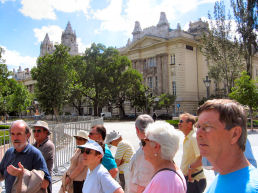
Elemer told us that the Nazis blew up all of Budapest’s bridges.
The whole group then took tram #2A to the hotel. We had to get off at the fourth stop. I noticed that when Elemer showed us how many stops, he held up four fingers; he did not use his thumb. I asked Susana about it; she attributed this to the time that he had spent in America. We made our way to Hotel Erzsébet. We arrived right at 3:30. Bojan had the bus parked right in front of the hotel. They really made life easy for us on this trip. There was even an elevator that could hold more than one person at a time.Sue and I were assigned room #111, which was on the first floor over the ground floor. It seemed to be quite a nice room with both air conditioning and a little refrigerator. The bathroom even had a tub. However, there was nothing resembling a shower curtain. I felt pretty grungy from the day’s walking, so I took a shower. I was pretty sure that more water went into the tub than went onto the bathroom floor, but there was still enough on the floor to float the Hungarian admiral’s navy.
Even though the walking tour had been almost completely downhill from the top of Buda, Sue was completely wiped out. She slept all afternoon. She then took a bath in the huge tub in the room. By the time that she got out and got dressed we only had forty-five minutes until we had to leave for the night cruise on the Danube. When she told me that I should have told her how much time she had, I lost it, but I recovered my aplomb within a few seconds.We decided to eat at the restaurant right across the street, Pesti Lampás. This turned out to be a great choice. We were able to eat on their "terrace," which was really a courtyard. Only one other couple was dining there. The service was very good, and the food was spectacular. There was even a pleasant musical accompaniment for part of the meal. I had salmon with black (!) spaghetti, spinach, and cantaloupe and a glass of Stella Artois. Sue had a white wine to accompany her supper of goat cheese, mixed vegetables, and a pastry. I asked for the check as soon as the food was delivered, so we were able to make it to our assembly with at least ten seconds to spare.
The group walked down to pier 7. Along the way we made note of some landmarks on our street, including a supermarket named Match. We went into the Legenda cruise company. I never did see the name of the ship that we boarded.
The cruise on the Danube was a turning point for me. They served us champagne and a drink. We sat on the upper deck in an enclosed area. That was a good thing; it was quite windy, and the temperature was no higher than 60°. A video playing on a wide-screen TV provided a history of Buda and Pest, based on the buildings visible on either side of the river. The phrasing was overly dramatic, but I enjoyed it any way. The audio part was available in thirty languages. Sue and I had to share the audio device, but we had separate headphones.
The ship went south a little ways and then turned around. It then went all the way down to Margit Island and turned around. The views were nothing short of spectacular. Quite a few people dozed off during the cruise, but I really enjoyed it. I found it relaxing, amusing, and educational. It occurred to me that Rick Steves seemed to have discovered one secret of making sure that the people on the tour have a good time: keep the alcohol flowing. Sue’s second drink was another tall flute of champagne. I switched to beer. We walked back to the hotel in a jovial mood. When I got to the room I managed to get on to the Internet using someone’s unsecured wifi connection. The name of the router was just "dlink," so whoever owned it probably was still using the default. The signal was pretty weak. I could only maintain the connection for short periods. I remembered that the next stop would only be for one night; there would be no way to wash and dry clothes there. I therefore saw no choice other than devoting my last hour of wakefulness to laundering my clothes in the sink. I ran my clothes line from the showerhead to the end of the rack for the bath towels. This was just about long enough to hold my socks and underwear. The shirts I affixed to hooks and hangers.I felt pretty good about things when I went to bed. I had gone an entire day without breaking or losing anything. I had both batteries and scissors. Budapest seemed like an exciting city. I had a free Internet connection. Life was pretty good.
